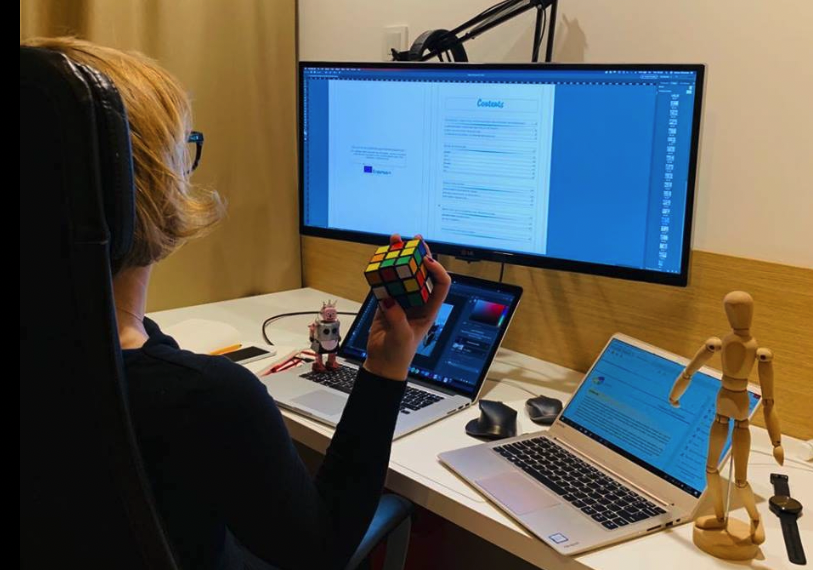Educators in the changing world
Digital tools and innovative approaches based on media have been gaining popularity among educators, both in the formal and non-formal sector. The reason for the shift in the methodologies we are using is directly related to the need of new solutions that became clear during the COVID-19 pandemic, that forced us out of our comfort zone and made us question the effectiveness of the old, known tools.
Currently the pandemic is not affecting us so much, at least in a sense that we can again organize our educational activities face to face most of the time rather than conducting the always challenging workshops online. But are we really back to the “old normal”? When looking at the realities around us, with global challenges affecting both educators and learners, it is clear that we have to accept and adjust to new reality, and the digital tools are here to stay.
When thinking of education in a digital era it is worth to reflect upon it a bit deeper than just to say that we need to do more things online. There are endless possibilities for improving education using more innovative, digital approaches. It is especially useful when working with learners at risk of exclusion who are facing adversities related to the current situation in the world. Apart from still living with the results of the pandemic, such as anxiety and general deterioration of the mental state, many of the learners we work with are affected by the challenging economic situation that results in difficulties to find a job that will be both financially stable and fulfilling. The ongoing war in Ukraine brought an unprecedented number of refugees who entered the European Union, which causes cultural tensions. These are new challenges that require new solutions, and digital tools can be one of the answers.
Common misconceptions
As advocates of digital approaches in education we very often talk to educators or teachers who are skeptical. First and most common question is what digital tools really are. Is it just doing things online? Does it require very specific technical knowledge or expensive equipment? Second doubt that is raised is that many of the educators think that digital tools are indeed effective, but only when working with youth who are already tech savvy. Is it really useful when working with adults? Or seniors? Migrants who don’t really know the language?
We hear these doubts and understand the uncertainty, but at the same time we are strongly convinced that digital tools and media-based approaches are so diverse that can be used by educators regardless of their technical knowledge and previous background. After all, it is not just doing things online, but rather finding and exploring approaches that are based on technology that make the learning process fun and creative. And adults can definitely benefit from them too, as long as the process is adjusted to their needs and competences.
Digital participation: the online course
To address the needs and context described above, we developed an online course on digital tools that is for anyone actively involved in adult education, both in formal and non-formal setting. The course, that is a result of a long term KA2 Erasmus+ project in the field of adult education, is a comprehensive guide that helps start incorporating more digitalized approaches and tools when working with learners at risk of exclusion.
The course is divided into 5 modules:
Module 1 explains in detail the concept of EMPOWERMENT as understanding it is crucial in order to be able to design educational content that is truly serving the needs of learners.
Module 2 is focused on PARTICIPATORY MEDIA and gives an overview of the methodological assumptions behind it. This module also explains what are the benefits of using media based tools for supporting learners at risk.
Module 3 covers the first of the two main methods on which this course focuses: DIGITAL STORYTELLING, explaining how to start using video making and storytelling in educational projects
Module 4 focuses on the second main method: PARTICIPATORY PHOTOGRAPHY, explaining how to incorporate photography for community building and need assessment.
Module 5 called GROWING IMPACT gives practical suggestions to educators as for how to start using digital approach in their daily work practice.
Apart from the main modules, the course features a resource space consisting of materials, such as presentations, handouts, and additional readings that can be used during workshops.
All the modules of this course are interactive – we use different type of materials to accommodate the needs of different types of learners. Apart from readings explaining theories, we included films that summarize different concepts covered in the course, interviews and podcasts with practitioners, as well as tests and questions for reflection.
The course is available in four languages: English, Danish, Italian, and Polish.
We believe that stories matter and all the voices – especially of those who are not represented in the mainstream media – should be heard loud and clear. As educators, it is our role to provide the learners with tools to convey their messages to the outside world and projects based on filmmaking and photography are a perfect way to do so.
That is why we have created the course that hopefully will help you understand the power of participatory media methods and gain new, practical skills to implement more creative and innovative projects.
This course was created during “Digital Participation: Engaging Diverse and Marginalized Communities” Erasmus+ KA2 in the field of adult education that was implemented by Fundacja Autokreacja (Poland), Upstream Stories (Denmark) and Mine Vaganti NGO (Italy)

